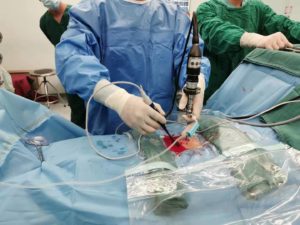Indications
Moderate-to-severe spinal stenosis including central, lateral,and foraminal, moderate-to-large HNP, with or without mild
instability; and grade I spondylolisthesis
Limitations
1. For foraminal stenosis in severely collapsed disc space with bony spur, decompression without damaging the exiting nerve is difficult
2. Decompression alone is not adequate for unstable spine as it requires instrumentation for stabilization
How to avoid complications
1. Use a controlled-pressure monitor irrigation pump to avoid over-increase of epidural hydrostatic pressure and
subsequent increase of intracranial pressure: 25 to 30 mmHg for lumbar surgery. Keep continuous outflow
of irrigating saline for clear view.
2. In order to prevent air embolismduring the procedures, be aware of clearing air bubbles in the irrigation pump line.
3. In case of severe stenosis, there may be a dense adhesion of ligamentum flavum to the dura. In that case, frequent gentle
tractions of ligamentum flavum from the dura with punch and pituitary forceps are helpful for spontaneous detachment. The careful insertion of a blunt hook over the dura will prevent tears in the dura, which leads to spontaneous adhesiolysis by saline irrigation into the epidural space between the dura and the overlying ligamentum flavum. If there is a dense adhesion between the dura and the ligamentum flavum, the outer layer is peeled off and the densely adhesed area is left over, keeping the dura intact.
4. The contralateral superior articular process and the upper lamina can be decompressed without nerve damage by undercutting the thick bony structure with burrs and the ultrasonic bone cutter. Then a small curette or a rongeur can be used to remove the remaining thin bony structures. These procedures are possible with clear vision under continuous saline irrigation.
5. In foraminal stenosis, the out-in approach starting at the extraforaminal area under wide and clear view is important.
Preoperative considerations
Preoperative CT scan and a foraminal-view MRI can be studied to find out the feasibility of this technique in an individual patient.
Specific intraoperative considerations
1. Saline irrigation pump is monitored to keep between 25 and 30 mmHg, depending on the patient’s condition to prevent increase of the epidural hydrostatic pressure and ICP with infusion of saline into the epidural space
2. Dural tears can be prevented by frequent piecemeal detachments of ligamentum flavum from the adhesed dura with saline irrigation into the potential space
Postoperative considerations
Surgical drains are inserted and kept for 24 h after surgery until spontaneous bleeding is controlled. A muscle balance physiotherapy staged regimen is recommended on the second day following surgery.
Specific perioperative considerations
(pre and postop workup, instructions for the postop care)
Routinely check pre- and postoperative CTand MRI scans for thorough evaluation of the main pathology related to the patient’s
symptoms. Patients should be counseled that there is likely to be some numbness or tingling over the dermatome of the nerve operated on, and neuroleptics may be prescribed until the symptoms subside.
